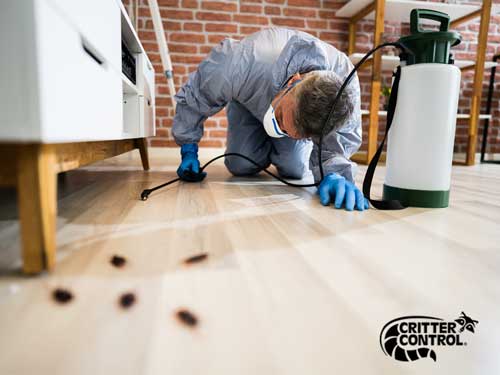A1 Bed Bug Exterminator Charlotte - Efficient and Affordable Services
A1 Bed Bug Exterminator Charlotte - Efficient and Affordable Services
Blog Article
Bed Bug Treatment Malfunction: Comparing Chemical Vs. Non-Chemical Solutions
In the world of parasite control, specifically when taking care of the consistent concern of bed pests, the choice between chemical and non-chemical treatment remedies can be a crucial one. Both techniques provide unique benefits and drawbacks, influencing variables such as effectiveness, safety and security considerations, and total expense. By analyzing the nuanced information of each technique, a clearer understanding of which path to go after in resolving a bed insect problem can be obtained.
Efficiency of Chemical Treatments
Chemical treatments for bed pest invasions have actually been widely acknowledged for their fast and powerful efficacy in eradicating these parasites. When thinking about the effectiveness of chemical treatments, it is important to comprehend that they can give a complete and quick option to a bed insect issue.
Furthermore, chemical therapies have the benefit of offering recurring results, meaning that they can remain to get rid of bed pests even after the first application. This recurring activity is especially advantageous in combating any type of prospective re-infestations. In addition, the fast activity of chemical treatments can bring relief to people dealing with serious bed insect invasions, enabling them to regain control of their space promptly.
Security Worry About Chemical Solutions
When using chemical solutions for bed pest treatment is guaranteeing the safety and security of residents and the environment,One important element that requires cautious factor to consider. While chemical therapies can be effective in removing bed pests, they may position dangers otherwise handled appropriately. Among the primary safety worry about chemical solutions is the possible harm they can create to human health. Direct exposure to certain chemicals utilized in bed pest therapies can cause breathing concerns, skin inflammation, or various other negative responses, particularly in individuals with pre-existing conditions or level of sensitivities. In addition, incorrect application or dosage of chemical pesticides can cause poisonous deposits sticking around in the treated area, positioning long-lasting health threats to residents.
Furthermore, the environmental impact of chemical solutions is an additional significant factor to consider. Some pesticides made use of in bed pest therapies may be harmful to beneficial pests, wild animals, and environments if they leach right into the dirt or water systems. It is important to make use of chemical therapies sensibly, complying with security standards, and thinking about much less toxic options to mitigate these dangers and guarantee the efficient and risk-free management of bed bug infestations.
Benefits of Non-Chemical Strategies
Taking into consideration the potential safety and security concerns and environmental effect associated with chemical solutions for bed insect treatment, checking out non-chemical approaches offers an encouraging option with a number of distinct advantages. Non-chemical therapies are eco pleasant, as they do not add to air or water pollution, making them a sustainable choice for insect control.
In addition, non-chemical solutions can be reliable in targeting bed bugs, including hard-to-reach areas where chemical therapies may not permeate - A1 charlotte pest control companies. Approaches such as warmth treatment, vacuuming, heavy steam cleaning, and mattress coverings supply complete elimination without the use of hazardous chemicals.
Limitations of Non-Chemical Treatments

Furthermore, non-chemical therapies frequently require several applications to accomplish successful obliteration. This can be lengthy and might not constantly assure full removal of all bed bugs and their eggs, specifically in hard-to-reach or surprise areas.
Moreover, the success of non-chemical therapies greatly relies upon correct implementation and thoroughness, which can be challenging for individuals without expert experience. Poor application of non-chemical techniques might lead to insufficient obliteration, leading to consistent invasions and the need for added therapies.
For that reason, while non-chemical treatments have their benefits, it is important to acknowledge these restrictions and consider them when figuring out the most effective strategy for managing bed bug problems.
Expense Contrast: Chemical Vs. Non-Chemical Options
Given the constraints linked with non-chemical therapies, an essential aspect to evaluate in the context of bed pest administration is the cost contrast between chemical and non-chemical alternatives. In contrast, non-chemical therapies like warm treatment or vapor can be much more pricey, with expenses ranging from $1,000 to $6,000 for an entire home. While the first cost of chemical therapies may appear lower, multiple treatments may be called for to completely remove the problem, potentially raising the general expense.
Verdict

Considering the potential safety concerns and environmental effect linked with chemical services for bed bug therapy, discovering non-chemical strategies offers a promising alternative with a number of distinctive benefits.Provided the constraints connected with non-chemical treatments, a vital aspect to review in the context of bed bug monitoring is the cost contrast between chemical and non-chemical options. In contrast, non-chemical therapies like warm treatment or heavy steam can be extra expensive, with prices ranging from $1,000 to $6,000 for a whole home. While the preliminary cost of chemical treatments may appear lower, numerous therapies may be called for to totally eliminate more helpful hints the problem, potentially enhancing the total price.In verdict, when contrasting chemical and non-chemical bed insect therapy options, it is important to think about performance, safety, benefits, restrictions, and expense.
Report this page